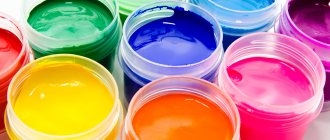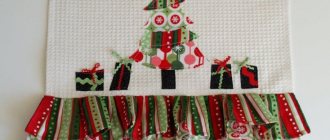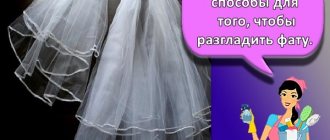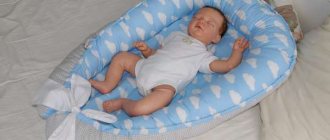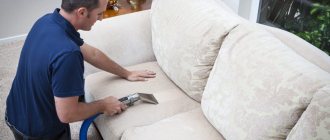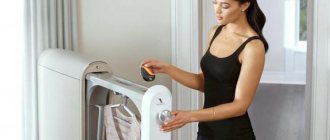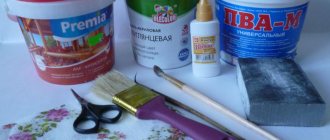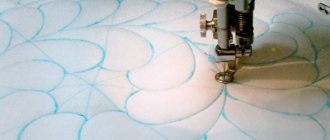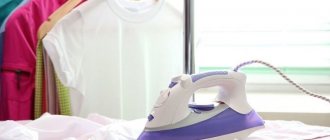What fabric can be dyed
There are a lot of fabrics for clothing. Conventionally, they can be divided into natural and artificial types. Cotton, silk, and linen are more suitable for thematic processing. The fact is that natural fabrics:
- They absorb new paint well;
- Less likely to react to various chemical dyes;
- They have a uniform structure of matter.
Combined fabrics such as viscose are less suitable for dyeing. In general, all budget and versatile products are made from several fabrics.
Therefore, it is better not to process artificially created synthetics manually, because it can quickly lose color.
If there is no professional service, you will have to select painting techniques and consumables depending on the type of synthetics:
- Bologna fabric – welcomes application of paint in two layers by hand;
- Polyester - reacts well to acrylic;
- Universal denim composition - renewed when using heated dye.
The composition of the fabric matters a lot when dyeing is at stake. The corresponding indicator also allows you to determine the complexity of processing.
Rating of quality fabric paints in jars
Javana S. Kreul
This set from a time-tested brand will be an excellent solution for both a novice artist and a professional. Can be used for painting thin fabrics and synthetic fabrics. Also used for drawing on paper, wood and leather. Suitable for working with different techniques. The package includes everything you need to get started right out of the box. The set contains 5 jars of 20 ml each, a reserve colorless outline, salt and two pieces of fabric 45x37 cm. Also included in the package is a brush, pins and stencils. The brand is one of the first manufacturers of varnishes and paints in Germany. The product range is wide and updated every year.
The average price of a set is 2158 rubles.
fabric paints Javana S. Kreul
Advantages:
- equipment;
- product from one of the best German manufacturers;
- multifunctionality;
- designed for dyeing not only fabric, but also other materials;
- safe composition.
Flaws:
- not identified.
Setacolor PEBEO
This set is designed for painting and coloring light-colored items. The water-based product can be used not only for painting, but also for decorating canvases and applying patterns of any complexity. The manufacturer assures that the supplied material is suitable for working with leather, non-woven fabrics, mixed fabrics, polyester, jacquard, velor, jersey, knitwear, wool and cotton. Paint color – matte. The strokes are applied evenly and do not smear. Do not affect the degree of elasticity of the selected fabric. It should be noted that the contents of the jars can be mixed with each other to obtain new shades. After opening, the jars are shaken thoroughly. After application, the smears will take an hour to dry completely.
This brand is one of the largest French manufacturers of materials and accessories for artists. The products first appeared on the shelves in 1919. Over the years, the quality of the goods supplied has improved, which has been repeatedly noted in numerous reviews. According to professional artists, it is this company that is best to buy the appropriate products and components when working with canvases.
Cost – 249 rubles.
fabric paints Setacolor PEBEO
Advantages:
- water based;
- the contents of the containers can be mixed with each other;
- wide range of finished products;
- affordable price;
- rulers are divided by type of fabric.
Flaws:
- not identified.
Grunge it Viva Decor
This popular model is designed for creating decorative elements and lettering in a grunge style. The model is recommended for use with products of natural origin. These include silk, linen or cotton. It is also allowed to use textiles that contain no more than 20% synthetic fibers. The composition penetrates deep into the fabric, and after washing it retains its original elasticity. Before use, shake the containers thoroughly. To avoid mistakes, it should be noted that you need to prepare the clothes for dyeing. We are talking about machine wash, excluding the use of softeners and conditioners.
To apply the design, you can use stamps, stencils, rollers, brushes or the blotting method. After completing the manipulations, you must leave the work surface alone for some time until it dries completely. To secure the application, you can use an iron (temperature no higher than 30°C).
How much does the kit cost? The purchase will cost 568 rubles.
fabric paints Grunge it Viva Decor
Advantages:
- ease of use;
- lack of turnover;
- can be mixed with each other;
- Baking sketches with an iron is allowed;
- German quality.
Flaws:
- high price.
RAY, set of 8 colors, 15 ml each
This set will be an excellent solution for those people who decorate things and clothing at home. Allows you to turn even your wildest fantasies into reality and transfer them to canvas. The basis is the use of water-based paints. The lines will fit well on both natural and synthetic fabrics without the risk of smudges. The colors are vibrant, eliminating the need to re-trace lines for best results. At the end of the manipulations, the manufacturer recommends securing the result by ironing. After such actions, the pattern will become resistant to subsequent washes.
Produced by a domestic brand that needs no introduction. Specializes in the production of goods for children's creativity and consumables. Due to this, many people know the company from their school desks. Modern equipment and technologies are responsible for the high quality of the products offered. The products are considered completely safe and enjoy a well-deserved reputation in the domestic market.
Average price – 115 rubles.
fabric paints LUCH, set of 8 colors, 15 ml each
Advantages:
- excellent light fastness;
- economical consumption;
- ease of application;
- safe composition;
- time-tested brand.
Flaws:
- not identified.
Which dye to choose for fabric
In addition to the origin of the fabric, the condition of the dye itself affects the ease of dyeing.
The latter may look like:
- Liquid mixture – suitable for spot painting;
- Spray can - used for painting large areas of fabric;
- Powder - used for various purposes.
If it is necessary to create a focus of attraction on the surface of clothing, you can use the so-called. rubber paint, which is liquid plastic.
It is used in a limited state, because... after drying it acquires a relatively rigid state.
Rating of the best paints for fabric in the form of outlines
DECOLA Paints for painting
This set includes 12 20 ml bottles. Designed for applying decorative patterns to synthetic, silk and natural fabrics. A great way to show your creativity and create a masterpiece at home. Due to the convenient form factor, the designs can be used by a beginner in the world of art. The product is suitable for free-form painting, as well as reservation using fabric contours. Dries quickly. To fix the color, heat treatment (iron) will be required. After 48 hours of drying, machine washing is allowed.
The substance penetrates deeply into the fibers. The package includes: gold, black, purple, sky blue, green, orange, white, silver, dark blue, turquoise, red and yellow pigment container. Containers should be kept tightly closed. After finishing work, auxiliary accessories should be thoroughly rinsed under warm running water. Before starting work, the composition is thoroughly mixed. Supplied in cardboard packaging with a standard logo.
How much does the kit cost? The purchase will cost 1252 rubles.
fabric paints DECOLA Paints for painting
Advantages:
- wide range of colors;
- rich shades;
- drying speed;
- ease of use;
- manufacturer's warranty.
Flaws:
- not identified.
TAIR Set of contour acrylic paint for fabric and leather
This popular model belongs to the category of acrylic paints that can be used to apply patterns to various fabrics and leather. These contours are produced in small tubes, which facilitates the subsequent process of applying the substance to the work surface. The composition can also be applied directly from the tube. Due to its optimal consistency, the substance penetrates deeply into the fabric fibers, giving a uniform color. It should be noted that the fabric will not lose elasticity and will remain just as soft.
Average price – 494 rubles.
fabric paints TAIR Set of contour acrylic paint for fabric and leather
Advantages:
- rich tones;
- ease of application;
- drying speed;
- multifunctionality;
- form factor.
Flaws:
- not identified.
PEBEO Paints for painting
This type of fabric paint is available in outline form. Due to the modern form factor, the composition can be applied without auxiliary accessories, provided that the person knows this technique. The color is rich, and the substance adheres well to the fabric, penetrating into the thickness of the fibers. The first wash can only be carried out on a delicate cycle at 40°C, and not earlier than 72 hours after the pattern has completely dried.
Cost – 349 rubles.
fabric paints PEBEO Paints for painting
Advantages:
- drying speed;
- ease of use;
- rich tone;
- convenient form factor;
- wide range of colors.
Flaws:
- not identified.
Acrylic
Acrylic-based dyes are the most common material for giving the desired look to fabric.
This paint has the following advantages:
- Dilution in water – reduces product consumption and minimizes the release of toxic substances;
- Quick drying – speeds up the painting process;
- Mixing different colors helps create a unique palette.
It is recommended to paint natural fibers with acrylic paint - cotton, silk, linen. The finished fabric can be washed by hand at temperatures up to 30 degrees Celsius.
Preliminary tips before staining
Before embarking on such a responsible task, you need to know about all the possible consequences. And be sure to follow these recommendations to avoid unexpected effects.
In general, we would advise you not to get excited, but to check the result on some old thing. It’s easy to ruin it, but it will be impossible to wash the paint if something doesn’t work out.
So, what you should understand before coloring:
- Only cotton fabric, wool or linen can be dyed ideally, while the rest can simply be taken in pieces. Unfortunately, there are now often cases when the label states that it is 100% cotton, but in reality it turns out completely differently. Therefore, if you are not completely sure of the composition, try to pre-dye a small piece of fabric, specifically from this product.
- You can only dye a well-washed item, and put it in the machine wet. Otherwise, the paint will lie unevenly.
- Paint cannot completely cover all stains. If your stain is much lighter than the main fabric, then it will be visible in any case.
- Painting a white thing black is unlikely to work. It will turn out dark gray, at best. To achieve deep black, you will need more than one paint job.
- You must understand that the painted item will then fade. And it is not recommended to wash it in a machine, with other things, until five washes. Only after this will she stop getting dirty.
- Synthetics are almost never painted, no matter what paint manufacturers say. But there are rare exceptions, of course. Therefore, try on a piece of fabric to avoid a “spotty” result.
- The exact color indicated on the packaging only comes out when you dye it on a white item. If you apply it to other shades, the result will be slightly different. But, at least in the declared color scheme! In general, almost roulette.
- As a rule, the threads used to stitch the fabric are made of synthetics, as they are stronger and more durable. And be prepared for the fact that the main fabric will be dyed, but the threads will remain the same color. So, figure out in advance how they will be combined later.
- Never add conditioner during the painting process! The paint will come out in spots.
- Rust stains are very difficult to paint.
- Denim material is dyed on both sides
See also -
How to turn on a washing machine
Aniline
Aniline dyes are produced in powder and liquid form. Therefore, if you need to paint a thing, you have to pour the completely prepared solution into a container or aerosol spray.
As for the properties of aniline dye, they are in many ways similar to the properties of acrylic:
- Possibility of dissolving consumables in water;
- Suitability for natural fabrics;
- Mixing different colors;
- Accelerated drying.
True, the last two properties work when using hot water. In particular, we are talking about a temperature of 60-95 degrees. But in its finished state, aniline paint is resistant to washing solutions.
Another pleasant fact is that aniline is suitable for mixed fabrics, provided that the proportion of artificial fibers is no more than 60 percent.
How to dye fabric: dyeing methods
When choosing paint for clothes, read the packaging about how to dye the fabric. At home, this can be done manually (with or without boiling) or dyeing in a washing machine. Paints for hardware use may only be used at home at your own risk.
A familiar method for dyeing fabrics at home is boiling in a dye solution.
Preparing clothes for dyeing
The first is to correctly determine the amount of pigment to obtain the desired color. Clothes paints are usually sold in bags, less often in jars or tubes. One package is designed to paint a certain amount of canvas. So first weigh the item(s) and see how many packages or weight of pigment you need. If you need a lighter shade than shown on the package, add less pigment; if darker, add more pigment than recommended.
Paint for home textile painting Ideal has a table for selecting the weight of the item and the amount of paint
Second point : worn items must be washed. If there are greasy stains, they must be removed. It is very important. Otherwise, after painting, there will be a spot of a lighter (usually) color in this place. You can use dishwashing detergent or even bleach for washing. But all detergent residues must be thoroughly removed (double rinsing in the washing machine can help with this).
Third : before painting, remove the fittings. Remove everything that can be removed/cut. There will also be lighter spots under the fittings, and the metal, when boiled, can react with the paint and give a completely different color.
Hand painting
To manually dye fabrics or clothes, you need an enamel or stainless steel container. Its volume should be at least 30% greater than the volume of the liquid in which the dye must be diluted. The pigment is diluted in water, brought to a boil, and wet items or fabrics are immersed. For some paints you need to add salt or soda. You need regular table rock salt or baking soda. If other components are required, they are indicated in the instructions.
Hand dyeing process in photo
For some paints the fabric can be dry, for others it must be damp or even wet. But the item or fabric must be clean.
When using aniline dyes, do not add salt immediately. It is better to dissolve it later, when the item is painted. Pour out a liter of solution, dilute the required amount of salt in it and, vigorously stirring, pour the solution into the container with the item/fabric to be dyed. Bring the temperature to the limit a couple of times (in most cases it is 70-90°C).
For an even color, straighten out any creases before dipping into the dye.
If you do it as in the photo, you will get one of the “marble” color options. For some paints, boiling is necessary, for others it is enough to soak the fabric in a warm or cool solution. In any case, the dye should cover the entire thing. To obtain a uniform color, the fabric should be “stirred”. Seams and places of double/triple application of fabric must be pressed down more often and more actively. When boiling, plastic or wooden (without bark) sticks/tongs are used for this purpose. If the solution is lukewarm, you can do this with gloved hands.
Jeans with stretch should not be boiled or heated too much. To dye stretch fabrics, look for dyes with a temperature range of no more than 40°C
After the specified time has passed or you have achieved the desired color, the fabric is taken out and rinsed in warm water until the water is clear. Sometimes it is necessary to add vinegar to the water. All details of the process are indicated on the packaging or in the instructions.
Dyeing clothes in the washing machine
It's easier and faster to dye things in the washing machine. There are special dyes for this. On the packaging it says “fabric dye for dyeing in the washing machine.” They are poured into a tank (drum) or into a powder compartment. The clothes are placed in the drum and the washing mode recommended in the instructions is turned on. Some dyes require subsequent washing with detergent at a “normal” temperature for this type of fabric. Actually, that's all. After completing the program, take out the dyed item and dry it away from sunlight.
The packaging or instructions must indicate the painting methods. This Simplicol paint can also be used for dyeing in washing machines.
How does the machine react to paint? It practically does not react at all to special ones. Sometimes the sealing gum is painted, but the color gradually washes out. To guarantee, after dyeing, run an empty washing machine (or an almost empty one, in which rags or things that are not afraid to be touched up a little) are washed for a short program. The powder is guaranteed to wash away paint residues and you can then use the washing machine without any problems.
Stamp ink
This dye owes its name to the stamp. The fact is that initially stamp inks were used for office stamps, because... their composition takes on a convex shape and dries quickly.
However, when changing the stamp dye formulation, the following opportunities opened up for designers:
- Good impregnation due to water-glycerin base;
- Resistant to bleaches when using alcohol-based paint;
- Obtaining a bright fragment using an oil base (the downside is that the oil takes a long time to dry).
As a result, stamp inks differ from each other depending on the base for dilution. The paint itself is environmentally friendly.
It comes in the form of a liquid that must be diluted with a specific solution. The choice of the latter depends directly on the composition (base). Therefore, the use of stamp ink sometimes portends difficulties and expenses.
This shows the unpopularity of the corresponding dye. On the other hand, it can be used to a limited extent - to create individual bright fragments.
TOP best paints in bags for washing machines
SIMPLICOL Back to black
This model will be useful for those housewives who want to refresh the appearance of some things or repaint items in a more advantageous shade. Powder color is black. A characteristic feature of the product is the fact that it can be placed in a washing machine, which eliminates the need for manual manipulation. The bag contains 400 g of coloring powder. The product belongs to the universal category and is suitable for painting any canvas. It should be noted that in order to avoid surprises, after “coloring” you should use the “additional rinse” option.
Cost – 777 rub.
fabric paints SIMPLICOL Back to black
Advantages:
- does not cause allergic reactions;
- absence of foreign aromas;
- you can achieve excellent results with one sachet;
- designed for a large volume of things;
- convenient form factor;
- wide range of colors;
- ease of use.
Flaws:
- high price.
IDEAL, Black
This popular model is designed for dyeing and refreshing the color of your favorite things. To avoid mistakes when choosing, it should be noted that tone uniformity can be achieved at 30°C. In addition, the color will not wash out afterwards, and things will not fade and spoil other clothes. The manufacturer recommends using fabric that contains no more than 50% synthetic fibers. As this indicator increases, the degree of staining will decrease. Based on the instructions provided by the manufacturer, it is necessary to carry out the following manipulations: the upper part of the bag is cut off, after which it is placed in a vertical position inside the drum. The risk of spillage must be eliminated before starting the program. Then things are placed inside the drum (no more than 2 kg per bag). The item must be dry.
To refresh the color, use the delicate mode at 30°C. To obtain a rich and intense tone, it is recommended to use water at a temperature of 40°C. At the end of the program, the bags are removed and the normal mode starts using detergents. The temperature regime is 40°C, which will fix the color and eliminate the risk of its subsequent washing out. Drying is carried out as usual.
How much does a packet cost? The purchase will cost 1158 rubles.
fabric paints IDEAL, Black
Advantages:
- persistent and uniform tone;
- does not cause allergic reactions;
- the smell goes away quickly (after the first wash);
- no need for manual manipulation;
- wide range of colors.
Flaws:
- high price.
Jeans Fabric Paint
This dye belongs to the aniline category and is used to dye and restore the color of fabric. Can be used for both machine and hand washing. The brand offers 25 tones, which will allow you to choose the best option based on personal preferences. Combining colors is also allowed. It is used for dyeing synthetic and natural fibers, including silk, wool, viscose, linen and cotton. The bag is designed for 1 kg of dry things. This indicator should be adhered to. For greater convenience in subsequent use, it should be noted that the set includes disposable gloves. Supplied in a cardboard box with instructions inside. The absence of a persistent chemical aroma, both dry and after wet, deserves special attention. Package weight – 20 g.
Average price – 125 rubles.
fabric paints Jeans fabric paint
Advantages:
- product from a domestic manufacturer;
- lasting color the first time;
- does not shed;
- no chemical smell;
- wide range of tones.
Flaws:
- not identified.
Marabu FASHION COLOR
This product is characterized by increased ease of use. Suitable for processing mixed fabrics, as well as viscose, linen and cotton. The maximum permissible percentage of synthetic fibers is 20%. Only in this case the user will be able to achieve the best result. Delicate and thin fabrics (silk) are best processed by hand. In this case, the sequence of actions will be different. The instructions are supplied by the manufacturer and must be followed. White canvases are dyed better than others. An appropriate sign for repainting items is also provided.
To achieve the best effect with dark canvases, it is better to pre-bleach them by hand. Afterwards washing is carried out using special detergents. This will remove any remaining bleach from the fibers. 30 g of powder is enough to process 0.5-1 kg of things. Additionally you will need 1 kg of table salt. If you follow the attached instructions, the fabric will not fade. The maximum permissible temperature regime for processed items is 90°C.
You can buy the packaging at a price of 830 rubles.
fabric paints Marabu FASHION COLOR
Advantages:
- wide range of colors;
- efficiency;
- ease of use;
- absence of foreign aroma;
- German quality.
Flaws:
- high price.
Fluorescent dye
This paint is also called luminous and invisible. The fact is that the substance plastisol, when a fluorescent plasticizer is added, changes its color depending on the effect of UV radiation. Moreover, the colors themselves can be red, pink, yellow, etc.
It is advantageous to use plastisol-based dye for the following purposes:
- Decoration of masquerade costumes;
- Drawing of club clothes and shoes;
- Design of sportswear and children's clothing to make it visible in the evening;
- Logo printing.
Plastisol-based dye has a relatively high level of viscosity. Therefore, it is recommended to use it as a covering material in certain areas.
If the fabric needs to be made completely luminous, then the thematic dye will have to be well diluted.
TOP best paints for fabric in the form of spray cans
LILACK Fabric Design
This aerosol acrylic paint comes in 220mm cans. The colors in the line are different, including glow-in-the-dark colors. It is used to restore tone, dye and decorate fabric products at home. The colors can be mixed with each other, based on numerous reviews on the Internet. Suitable for both natural and mixed compositions, in which there is no more than 20% artificial fibers. The colors do not wash out or fade in the sun. A lemon-colored luminescent spray can allows you to make unusual designs that will glow in the dark.
To avoid mistakes when choosing, you should pay attention to the fact that after application and complete drying, the pattern will not wash off. To secure the decorative element, no auxiliary manipulations are required. The treated fabric retains its original elasticity and softness. Suitable for both stencil techniques and knotting or shibori.
Cost – 399 rubles.
fabric paints LILACK Fabric Design
Advantages:
- uniform application;
- drying speed;
- resistance to ultraviolet rays;
- ease of use;
- wide range of colors.
Flaws:
- not identified.
CENTROPEN Textile Spray
This set consists of 6 spray paint cans. The set includes a container with green, yellow, brown, black, red and blue. The compositions can be mixed with each other, which will diversify the artist’s existing arsenal. The product from a time-tested manufacturer is in high demand not only among European, but also domestic consumers. An excellent solution for refreshing your favorite clothes or creating an unusual decorative element on a T-shirt. The opportunity to diversify a child’s wardrobe deserves special attention. Children should not use aerosols on their own, however, such manipulations can be carried out together with parents and fun stencils.
Average price – 2069 rub.
fabric paints CENTROPEN Textile Spray
Advantages:
- durability;
- ease of use;
- equipment;
- multifunctionality;
- no preliminary preparation of the working surface is required.
Flaws:
- high price.
Marabu Textile Design
This model also belongs to the aerosol category. The water-based product is sold in 150 ml. Before choosing this product, it should be noted that after applying the ornament, it is necessary to subject the material to a delicate wash at 30°C. The substance does not require subsequent fixation. It is not recommended to apply the composition to places that will subsequently come into contact with the skin. After oxidation, crumbling may begin. If the drawing is done by hand, then the distance between the can and the working surface should be 5 cm; if a stencil is used or an arbitrary application is made without auxiliary accessories - 25 cm. Before starting manipulations, the container is shaken thoroughly for several minutes. The can is held strictly vertically. The nozzle is cleaned before next use.
Cost – 632 rubles.
fabric paints Marabu Textile Design
Advantages:
- ease of use;
- large volume;
- drying speed;
- no additional manipulations are required;
- wide range of colors.
Flaws:
- not identified.
Natural paints
If the environmental purity of the fabric is at stake, then natural raw materials can be used as a coloring pigment.
The choice of the latter depends on the desired color design:
- Red – raspberries or onion peels;
- Yellow – leaves of birch or wormwood;
- Green – juniper berries or sorrel greens;
- Blue – blueberries and blackberries.
Ready-made colors are mixed with each other to obtain complex solutions - orange, purple, brown, etc.
Soy milk must be used as a binder. It is applied to the fabric before dyeing or mixed with a solution of natural dye in a 1:1 ratio. The solution itself is prepared by infusion or boiling
TOP best fabric paints in the form of markers
Darwi TEX Glitter
This product is characterized by the presence of rich tone and glitter, which should be taken into account during the selection process. It is a ready-to-use acrylic substance that is water-based. The product is considered safe and does not have a strong aroma. Release form – markers. Designed to work with any fabric, both natural and synthetic. Before first use, the marker should be primed. The tip is meant to rest against the test surface until it is completely wet. After the tip has been painted in the selected tone, the design is ready for subsequent use.
To avoid mistakes, markers should be stored with the caps facing down. Before starting work, the device is shaken. If the tip accidentally turns a different color, you should not clean it with cloth napkins. The manufacturer recommends rinsing it under running water. After finishing, the pattern is ironed for 5 minutes (from the wrong side). To avoid the picture being printed on the reverse side, you should use a lining. Afterwards, items can be washed at a temperature of no more than 60°C.
Average price – 310 rubles.
fabric paints Darwi TEX Glitter
Advantages:
- the presence of sparkles;
- form factor;
- wide palette;
- water based;
- ease of use.
Flaws:
- not identified.
TAIR Pearl Art
These contours are used to create pearls and are in high demand among artists and needlewomen. Allows you to create pearlescent peas of different diameters that look great on any fabric. A water-based acrylic composition is used. The product belongs to the universal category and can be applied to any type of surface. We are talking not only about natural and synthetic fabrics, but also plastic, metal, wood and paper. Available in a plastic tube with a capacity of 25 ml. The presence of a plastic lid, which is equipped with child protection, deserves special attention.
Cost – 287 rubles.
fabric paints TAIR Pearl Art
Advantages:
- sticks well on different surfaces;
- the result is always smooth hemispheres;
- wide scope of application;
- water base;
- ease of use.
Flaws:
- not identified.
Marabu-Textil Painter Glitter 3 mm
This marker belongs to the category of light-resistant, and is used for drawing on various canvases of synthetic or natural origin. To avoid mistakes when choosing, it should be noted that the marker is intended for applying ornaments to an unfinished surface. The thickness of the lead is 3 mm. There is no chemical smell. Before starting work, shake the felt-tip pen thoroughly for several minutes. The cap is removed, and the tip rests on a piece of material until it is completely painted in the selected tone. At the end of the manipulations, the drawing is left alone for half an hour until completely dry. To fix the color, use an iron (cotton mode - 150°C). Wash at a temperature not exceeding 40°C.
Average price – 253 rubles.
fabric paints Marabu-Textil Painter Glitter 3 mm
Advantages:
- drying speed;
- precision of application;
- ease of use;
- wide palette of colors;
- manufacturer's warranty.
Flaws:
- not identified.
Painting fabric (step by step instructions)
The application of paint to clothing can be partial or complete, manual or automatic. Since the target audience does not have a stencil for silk-screen printing, the paint will have to be applied manually.
The exception is the use of a washing machine. Sometimes, when the item rotates inside the drum, the paint is applied unevenly, and the washing machine itself becomes dirty.
Therefore, it is better to carry out full painting of the product inside a deep basin. In any case, tissue renewal occurs in stages:
- First you need to draw a sketch and design your future clothes;
- Next, the product is treated with etching paint to destroy the previous background with a pattern;
- The next stage is preparing a solution according to the origin of the dye;
- Next, the product is immersed in a solution to create a background;
- The dried background is decorated using a stencil.
For better resistance to washing powders, the background is painted in two or three layers. Decor can be applied with a brush or marker. To prevent the print from extending beyond the stencil, cellophane film is placed under it and on the back side of the fabric.
A slightly heated iron promotes the formation and accelerated drying of the print. However, when using quick-drying acrylic, you can avoid applying an iron over the design.
Adding blue shades
There are also several methods for dyeing pants blue.
First of all, the use of ordinary blue - a mixture of methylene blue with starch. It is suitable for refreshing the product and giving it a more saturated color.
Manual method
- The dye is diluted in the amount of warm water indicated on the package, add a couple of tablespoons of table salt .
- Pants are placed in the resulting mixture. It is recommended to leave the product for several hours to obtain a bright and rich shade.
- Turn over about once every 2 hours to ensure even coloring.
- Before completing the process, you can prepare a solution with vinegar. Add 2 tablespoons of vinegar per liter of water . It is necessary to soak the painted product in the resulting solution for several minutes to consolidate the result. Then rinse several times.
Machine method
- When painting in a machine, powder dye is more suitable . It is diluted with boiling water and poured directly into the drum .
- Next come the trousers . It is recommended to set the mode to “Boiling”.
- While the product is going through the stages of dyeing, prepare a solution with vinegar . must be kept in it for at least 15 minutes.
- Afterwards rinse with water .
These steps will help restore your trousers’ rich color and well-groomed appearance.
Photo of paint for clothes
How to make dumplings
Varenki are painted not with paint, but with ordinary, cheap bleach. In order to achieve the effect of spotting and dark stripes, the legs need to be carefully twisted in a spiral.
You can use rubber bands and you will get the effect of stars and spots. In general, there is huge scope for imagination. Try it! Moreover, fashion is coming back and such jeans are now quite relevant.
Once you have twisted the fabric, place it in a bucket, add bleach according to the instructions on the package and turn on the gas. They should boil for 10 minutes.
Then, of course, you wash them thoroughly with powder.
How to restore a coat. How to tidy up your cashmere coat
Cashmere is a very popular fabric for outerwear, which transforms a woman, giving her appearance elegance and style. Over time, it becomes necessary to wash and clean it. How to wash a cashmere coat, should you entrust this task to professionals or try to do it yourself?
Dry clean
Having decided to dry-clean your cashmere coat, you should carefully inspect it again and mark problem areas to be sure of the desired result at the end of washing. You should not expect that everything will be correct during professional washing - worry about your item yourself, tell us what you expect from washing, where exactly the stains or heavy dirt are located. In this case, professionals will certainly wash your cashmere coat with due responsibility and care.
The only significant disadvantage of dry cleaning is the effect of chemical compounds on the fabric, and given that the coat is cashmere, each of these effects can be detrimental to your favorite item of clothing.
We wash it at home in a washing machine
It’s another matter if you decide to wash your cashmere coat yourself - the main thing in this case is to correctly follow the recommendations for caring for items made of cashmere, namely:
- wash at a temperature not exceeding 30 degrees,
- use a hand wash cycle or similar gentle cycle,
- do not use spin
- do not use bleach,
- Can be washed with the addition of conditioner.
Undesirable result
What should you be wary of when washing cashmere yourself? Due to the very delicate structure of the fabric, items may become deformed when washed. This happens because the fabric shrinks. The most undesirable result of washing may be a coat that has shrunk by a couple of sizes and the sagging lining is visible on the front side. Knowing this, you need to make every effort not to spoil your cashmere item.
Home cleaning by hand
If the coat is only slightly dirty, you can clean it by hand. To remove stains in the underarm area from the reverse side, it is necessary to treat the fabric with a damp sponge with a soap solution, and then with ammonia. The movements must be performed without friction and with slight pressure so as not to damage the appearance of the product.
All stains must be removed before general cleaning. To remove them, use talc; if they are traces of fat, spread it over the stain, clean it after a while and, if necessary, repeat the procedure. Another way to deal with greasy stains is Fairy type dishwashing detergent, which is used in a similar way to talc.
To remove stubborn stains, use a solution of glycerin and ammonia, which is used to treat the stain until it disappears.
For ease of use during general cleaning, secure the coat on hangers and fasten the buttons. For cashmere, use a mild soap solution, clean water and a clothes brush. Clean by wetting the brush alternately in the solution and in clean water, using circular movements from top to bottom, as if scraping off dirt.
Thus, after analyzing the complexity or ease of certain operations, you can make your choice between services and your own efforts - both are acceptable, since the result is important in both cases.
